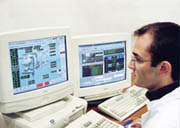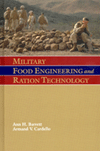
TPRO has helped process engineers gain a better understanding of heat flux and led to improved design. One example is the Jetcirc oven, introduced to the North American market in August. Three versions were created: direct convection, for maximum efficiency; indirect convection, which incorporates a split-flow heat exchanger for optimum humidity control; and direct recirculation, which combines radiant and convection heating.
Overseeing development work on oven refinements is Peter Cork, technical manager. Cork attended Cambridge University under the sponsorship of Baker Perkins, earning a degree in engineering science in 1974. He began his professional career as a design engineer of the company's confectionery equipment, then shifted to units for breakfast cereals, bread, cookies and crackers. During his tenure, the company has undergone several mergers. Today, APV Baker is part of Invensys, and Cork's duties include overseeing the development and specification of ovens and other equipment. Food Engineering recently spoke with Cork about TPRO, Jetcirc and the state of oven science.
FE: Describe the Jetcirc development process.
Cork: It's really part of continuous improvement. We overhauled our direct gas-fired oven for bread about five years ago, and we needed to do the same for our convection and recirculating ovens for cookies and crackers. In early 2003, we wrote a project charter to define the development work. We wanted to engineer more energy-efficient convection and recirculation ovens that could produce a range of cookies and biscuits and could be manufactured at a price that would represent good value. It had to bake more efficiently and be more modular in design. US recirculating ovens had been built in large sections; we wanted something that was easier to install and had more flexibility within the oven zones. We also wanted more convection heat transfer to reduce bake times.

Cork: The first is that a faster, more stable bake occurs when higher volumes of air at a lower temperature are applied. Drawing the air away from the product in a controlled, predictable manner improves consistency. In a typical convection oven, air is blown across the product surface and is pushed to the edge of the belt, where product is subjected to more heat flux. The new units incorporate more top plenum holes and more evacuation holes along the bottom plenum of the oven. A venturi effect is created, with faster air evacuation.
FE: How is faster baking at lower temperatures accomplished?
Cork: It goes back to the principle of available heat and the transfer rate to the product. If the air is more efficiently transferring the heat, it's possible to convey the same amount of heat to the product at a lower oven operating temperature. It's difficult to quantify the reduction, however, because it is product dependent.
FE: How did you optimize the number and position of the air holes?
Cork: You can make easy statements, but it's really a matter of understanding the airflow and relating it to the particular product. Our heat-transfer engineers analyzed data from ovens working in customers' factories and developed a model using computational fluid dynamics and a prototype oven zone built to measure the effects in practice and refine the number and position of the air holes. Velocity and volume are critical, though there's a limit. You can actually blow the product around on the band.
How the air is taken away also is important. Rather than letting the air return through a wide duct, we use small holes in specific locations within the zones.
FE: Why were multiple versions of the oven created?
Cork: Different oven modules allow us to tailor an oven to a particular product. Some products require direct convection, some run best with more radiant heat and others need a heat exchanger so that the amount of convection can be reduced or increased in proportion to a converse amount of radiation. For example, if some types of cookies are hit with a lot of hot air initially, the surface will dry out and cause improper baking to the interior. More radiation is called for initially, and more convection is appropriate at the end of the process. The science is in understanding the baking profile of what you are producing, then understanding the variables that affect it.
FE: What role did the thermal performance research oven play in this project?
Cork: TPRO has helped understanding of the baking profile of a variety of products by measuring process variables while baking is taking place, in ways a production oven can't. It's used a lot with bread, in which case we might use temperature probes and download the data later for analysis. For cookies and crackers, it's used with data loggers.
TPRO is a compact unit equipped with multiple sensors to monitor what is going on with the product. It's about 10 ft. high, 10 ft. long and 5 ft. wide. Conditions in the chamber can be changed very rapidly to emulate what would happen as product travels from zone to zone in a large commercial oven.
FE: Was the application of data loggers something new in cookie-oven research?
Cork: Relatively new. Probes and data loggers have existed for years, of course, but they're evolving. We're using a logger from Digitron Instrumentation that is very precise and accurate in measuring heat flux from air convection, conduction from the band and radiation from internal surfaces. In the past, you could measure airflow and temperature in a zone, but the actual heat flux going into the product can vary tremendously. Today's technology delivers lots of data on what is occurring in terms of baking and drying.
FE: United Biscuit is using a vision system from APV Baker and Dipix Technologies to control product color. Is that a prototype system?
Cork: The technology is now well established and is used for more than color measurement. It also detects variation in product shape and can distinguish constituents in a product, such as chocolate chips in cookies. Dipix developed the technology. It's not a closed loop control. Our control system receives information from the vision system then relays the results to the oven operator. Cameras can be installed off-line or right after product exits the oven.
FE: Minimizing or removing operator decision-making is a goal of many automation efforts. How close is it in oven control?
Cork: There usually are a number of parameters with cookies that can be altered when deviation from a steady state begins to occur, but you have to make some assumptions. If the process is automated, they might not necessarily be the correct assumptions. A skilled operator will be needed for the foreseeable future.
We're already using closed loop control in some applications. For instance, a change in finished goods may be due to something that's happened in dough mixing and forming. Before you can decide which parameter to adjust, you have to understand what caused the change. The Dipix system gives the operator an early warning before product goes out of spec. As process measurement continues to develop, I'm sure that closed loop control will become established.
FE: What is the current focus at the technology center?
Cork: The work we do is really a mixture of machinery building and the development of process solutions. We're very conscious of the obesity issue and the need for manufacturers to supply healthier products. That leads to formulations with innovative new ingredients. Consequently, the process may need to be adapted, which may require modifications to the machinery itself.
For example, there is tremendous interest in low-carb snacks and cereals. It didn't require radical change to adapt our twin-screw extruders to those types of products, but we had to understand what had to be fine tuned and what parts had to be added or adjusted when the machine was set up to produce those products. Designing a flexible machine in the first place is a critical first step.


